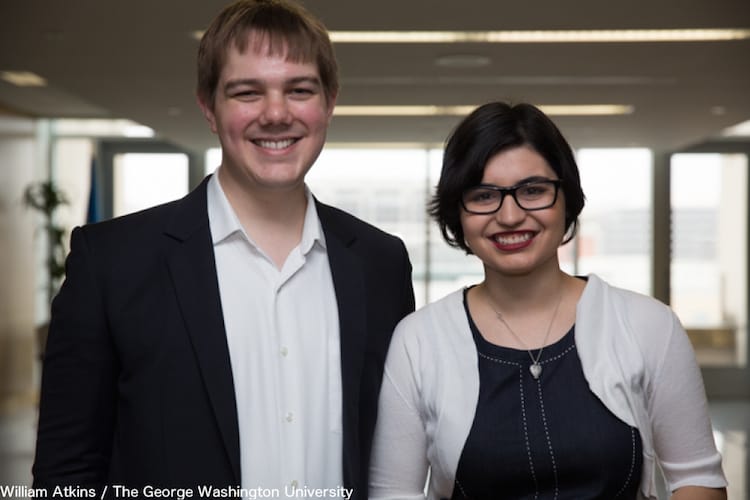Maria Rose, a student at the Public Health Program at American University, is making waves with an innovative tool that aims to reduce food waste by more efficiently connecting food donations to food pantries. After attending the World Food Prize’s Iowa Youth Institute, Rose put together, what she calls, the Matching Excess and Needs for Stability (MEANS) Database. The tool is already helping prevent food waste by connecting available food to those in need. From the Clinton Hunger Leadership Award to the George Washington University Business Plan Competition, Rose’s project is receiving quite a lot of recognition and support. Food Tank spoke with Ms. Rose to find out more about the project and how her hard work is combating hunger in communities across the United States.
Food Tank (FT): Can you tell us about the Matching Excess and Needs for Stability (MEANS) Database and how it helps food pantries communicate with one another to prevent waste.
Maria Belding (MB): MEANS is an online platform for food pantries and the donors who want to supply them. We’re an online database system for creating good in struggling communities. These agencies tell us where they are, the kind of food that they need and how far they’re willing to go to get it. Then, they receive emails from us when any item matching those criteria becomes available. American emergency feeding systems waste an estimated US$650 million a year in goods due to excess or expiration—they get too much of one kind of product rapidly nearing the end of its shelf life, can’t distribute it to their clients in time, and are forced to throw it out. We help these agencies move that extra food to another community organization instead of a trash can, and give retailers and other donors an easier platform to do the same.
FT: What inspired you to organize this powerful information-sharing tool?
MB: I started working in my church’s food pantry when I was about six years old. As I got older and more involved, I started to notice some frustrating patterns. The clients who came when I was seven were the same ones who came when I was 14, and 18, and they’re still there when I come home for breaks at 19. These individuals didn’t have the tools they needed to move forward and make progress against their poverty – they were putting all of their efforts into just staying afloat. Meanwhile, while our line of people to serve frequently snaked out the church door, I was throwing away massive amounts of food from over-sized, now-expired donations. After having to fill an entire dumpster one afternoon with mac and cheese past its date, I had the stereotypical entrepreneur’s thought: “there has to be a better way to do this.” There is, and MEANS was born.
FT: What are your plans for expanding the work of the MEANS Database?
MB: Right now, we have users in 12 states representing more than 1500 partner agencies. We’ve been focusing on those 12 states and gotten users in 9 new cities in the past week alone. We now have significant hubs in D.C., Rhode Island, and Iowa, with pantries joining in in Baltimore, MD and Philadelphia, PA. Over the summer, myself and my staff will be working to reach out to as many emergency feeding systems as possible and engaging retail donors as well. One of the cool things about what we’re doing is what we’ve nicknamed our “empty inbox” promise—if someone is the first to use MEANS in their geographic area, or there is no food matching their criteria available, they don’t get notifications from us. No daily email, no newsletter, no inbox clogging. MEANS lies dormant unless and until food you’ve told us you care about is in the area you care about. The only time someone receives emails from us is when there is food available, and our service is completely and forever free, so it’s a pretty easy sell.
FT: How did the World Food Prize Wallace-Carver fellowship (WCF) you received help support your development of the MEANS Database?
MB: I actually met MEANS’ COO and tech director through the WCF’s Washington Week kick-off. All of the interns spent a week in D.C. meeting agricultural and food policy leaders, and one of my fellow Wallace-Carvers later introduced me to his older brother, a programmer with an interest in improving efficiency. Grant has written every line of code for MEANS, and without him, the project literally doesn’t exist. I also met one of my strongest staffers at the World Food Prize’s Global Youth Institute the following fall. Since I had been a Wallace-Carver, I was invited to serve on the event staff and manage a group of competing students. One of them has since become MEANS’ Director of Partner Relations.
We got some great news last week. Kody Olson, who is MEANS’ director of Partner Relations, was just awarded the WCF for 2015. This brings our total World Food Prize count to 1 finalist GYI speaker, 2 Borlaug-Ruan interns, 2 Wallace-Carvers, and 3 GYI qualifiers. Not bad for a staff that has 3 World Food Prize alumni!
FT: Are you currently working on any new projects?
MB: Unless learning to do the splits counts, MEANS is my earth, moon, and stars at the moment. The joke among my friends is that MEANS isn’t my baby, because I’ve been nurturing it for three years. At this point, MEANS is my toddler!










